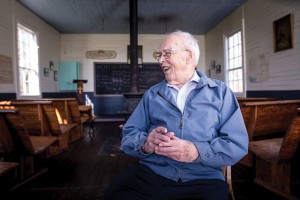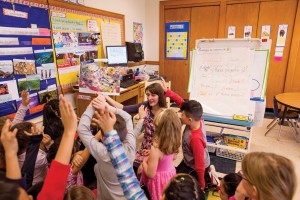
Harold Lehman ’36 sits in the Whitmer Schoolhouse in the Valley Brethren-Mennonite Heritage Center. The building is similar to the two-room schoolhouses of the Shenandoah Valley where he first started teaching. A third-generation educator, Lehman was also a professor of education at EMU and at James Madison University. (Photo by Jon Styer)
Tell Harold Lehman ’36 that 402 of 1334 Eastern Mennonite University alumni working in education live in Virginia and he is not surprised at all. Furthermore, he’s not surprised at the extraordinary number of educators who currently live and work in the Shenandoah Valley itself.
Teachers prepared for their careers by Eastern Mennonite have shaped the minds, bodies and characters of thousands of children – and generations of citizens.
Sifting through the research of two local historians, Lehman found that in the late 19th and early 20th centuries, more than 75 Mennonites taught in one- and two-room public schoolhouses up and down the Valley. Of course, not all of these teachers were prepared by Eastern Mennonite’s program; there was also Madison College and Bridgewater College – both of which Lehman attended. But it’s safe to say the unique Mennonite influence is well-rooted and thriving in this part of Virginia.
Lehman himself taught from 1939-1941 in rural two-room schoolhouses, first at Criders and then at Fulks Run, about 25-35 miles northwest of Harrisonburg: “The longer you taught, the closer they moved you toward Harrisonburg,” he joked. His monthly salary was $65. On weekdays, he boarded near the school; his landlady charged $13 a month, “and $12 if I’d milk the cow.” He chose the higher rate.
Lehman still has the leather-bound roll book – daily checkmarks were consistent at the beginning but tailed off in the winter – and memories of schoolyard antics, including one wrestling match with a truculent seventh-grader that he engaged in reluctantly, but won handily. “Not being an experienced wrestler, I think I was as surprised as he was,” Lehman said.
Eighteen when he started teaching, Lehman was not much older than his students. He had graduated from Eastern Mennonite School in 1936, which went through what is now considered 11th grade, and then stayed on at the college to complete the two years of coursework required to teach elementary school. That meant he took classes from his father, Daniel Webster Lehman – for some years, a one-man education department and recreation leader. “D.W.,” as he was called, often took part in sports competitions with students. (Like father, like son: a photo in the University Commons shows Harold, then professor of education, racket in hand “hopping the net” to congratulate his younger competition.)
To earn his high school teaching licensure and a bachelor’s degree, Lehman went to Bridgewater College for one year and to Madison College for three summers. “Local men doing their coursework to be high school teachers did take classes there,” Lehman says. “They just made sure we left campus at the end of the day.” JMU recently recognized him as their oldest living male graduate.
After four years of Civilian Public Service from 1943-46 working with mentally challenged children in New Jersey, Lehman returned to Park View with his wife Ruth Krady ’44 Lehman. He held a variety of positions, teaching physical education and serving as the high school principal and college registrar, before moving to James Madison University, where he was professor of secondary education and school administration until his retirement in 1986.
He was at EMU long enough to carry on the family tradition and teach his oldest son, Ken D. Lehman, who graduated in 1969 with a degree in history education. Ken is one of four sons – Daniel ’72, David ’78, and Larry ’79 – all of whom became college professors.
“I think we all realized that teaching and being a part of a university community, like the one we grew up in, was a pretty great life,” said Ken, who teaches Latin American history at Hampden-Sydney College in Farmville, Virginia.
A NEW MODEL OF TEACHING
Harold Lehman’s roll book – and those of local teachers for decades – was full of Yoders, Bowmans, Kiblers, Millers, Fulks, Shumakers. Now Kurdish, Russian, Syrian and Hispanic names fill current roll books, along with the German and Scots-Irish surnames of the Shenandoah Valley.
This demographic change mirrors one taking place worldwide: We live in a time of unprecedented human movement, with the number of refugees fleeing war and oppression or economic distress at the highest level in human history. Nearly 45 million foreign-born individuals live in the United States; 25 percent of the children in this country are children of immigrant parents (Pew Research Center, 2015).
However, the trend of Mennonite-prepared teachers in local schools that Harold Lehman observed earlier this century has not changed. Approximately 112 administrators and faculty in Harrisonburg City Public Schools (HCPS) hold degrees from EMU. With a curriculum that embraces diversity and builds cross-cultural competency, EMU’s teacher-graduates are especially well-prepared for classrooms that are global microcosms. HCPS has one of the highest populations of Limited English Proficient students in the state; according to district records, students come from 36 countries and speak 42 different languages.
In one unique HCPS program, 11 of 22 teachers and support staff, as well as three administrators (for a complete list, see page 16) have a degree from EMU.
In Room 23 of Keister Elementary School, Señora Jenna Martin-Trinka ‘07 holds up a picture book while 20 first-graders crane their necks and shift on their folded legs.

Jenna Martin-Trinka ’07 teaches her class of second-graders in Spanish at Keister Elementary School in Harrisonburg. (Photo by Jon Styer)
Ves una tortuga? she asks. Do you see a turtle?
For some students, she is speaking their native language. For others, she is teaching in a new language.
Enséñame, José, she says. José troops to the front and points to the tortuga. When he leaves the class 15 minutes later, he calls out Goodbye.
José is one of 440 students in the dual language programs at three elementary schools in Harrisonburg City Schools, in which students are taught for a half-day in Spanish and a half-day in English. Keister has one of the newest programs, while the oldest cohort at Smithland Elementary School is now in fifth grade. Plans are to offer the program through senior year of high school.
Martin-Trinka, who began her career as an ESL resource teacher, says she’s always wanted to work in the bilingual setting: “Teaching in Spanish was definitely a career goal, but I hadn’t imagined elementary school at all.”
Credentialed as a secondary Spanish teacher and a PreK-12 ESL teacher, she’s had to go back to school to earn an elementary credential. There is no special bilingual credential required in Virginia, but Martin-Trinka has pursued certification through an online University of Minnesota program to learn more about what is a fairly new kind of teaching in Virginia. In many ways, she credits her EMU training for the ability to handle the unique demands.
Collaboration, a skill she says was reinforced in the EMU curriculum, is a major part of the program’s success. “We rely on each other so much … The kindergarten teacher in this program, Mariela Formiconi, is from Argentina and I rely on her for help with Spanish, with content, with talking through the challenges, and my co-teacher Jennifer Kettelkamp and I share the same kids. There’s collaboration among teachers and administrators at all of our schools with this program. We need each other to grow and be better teachers serving our students, because this is so new.”
Inspiration comes daily, she says: “I love to see the interaction between kids, knowing that we’re teaching them in an authentic way and that they’re building cultural sensitivities. I love to see Hispanic students be leaders in our classrooms and see that we value everything they bring to the classroom. We want to be the kind of school system that authentically values what children have to offer and values cross cultural understanding. It really inspires me to do the work of teaching.”
EMU graduates working in Harrisonburg City Public Schools Dual Language Program:
At Smithland Elementary School: Rhonda Blosser ’86, Kindergarten (English); Mariana Lorenzana, MA ’14 (education), first grade (Spanish); Terri Gehman ’94, second grade (Spanish); Deanna Moore ’99, ESL.
At Keister Elementary School: Jenna Martin-Trinka ‘07, first grade (Spanish); Rose Jantzi ‘14, second grade (Spanish); Peyton Erb ’11, third grade (Spanish) beginning in fall 2016; Andrea Dayton ’06, ESL; Mark Miller ‘04, assistant principal.
At Waterman Elementary School: Camila Pandolfi ‘12, Kindergarten (Spanish); Elliot Swartz ’06, first grade (English); Staci Hartman ’93, assistant principal.
At Skyline Middle School: Ester Machado ’13, fifth grade (Spanish).
In HCPS administration: Jeremy Weaver ’95, executive director of elementary education/Title I.
